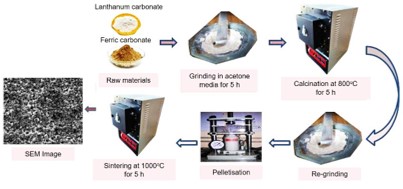Nanomaterials & Nanotechnology
Avadhesh Kumar Yadav
Abstract
In the past few decades, lanthanum ferrite has grown the importance in research due to attractive LPG/ humidity sensing and photolytic applications. In present study, the perovskite lanthanum ferrite was synthesized via solid state reaction route for three compositions by varying La/Fe ratio. The synthesized ...
Read More
In the past few decades, lanthanum ferrite has grown the importance in research due to attractive LPG/ humidity sensing and photolytic applications. In present study, the perovskite lanthanum ferrite was synthesized via solid state reaction route for three compositions by varying La/Fe ratio. The synthesized samples were characterized by Fourier transform spectroscopy, UV-vis spectroscopy, X-ray diffraction and scanning electron microscopy. The crystallization of lanthanum ferrite is confirmed by X-ray diffraction studies. The average crystallite size was found to be 45-50 nm. Surface morphological study of synthesized samples shows the uniform growth of the particles and grain which leaves the pores during its inter connection. These pores act as gas adsorption sites. The optical band gap of synthesized LaFeO3 samples were found to be 3.91-4.03 eV. Prepared samples were investigated for humidity sensing application. The average sensitivity of synthesized lanthanum ferrite samples was found to be 10.18-11.46 MΩ/%RH. The average sensitivity varies with the composition of the sample.

Majid Ndoye; Benoit Bideau; Aina Heritiana Rasolomboahanginjatovo; Éric Loranger; Dominic Deslandes; Frédéric Domingue
Abstract
In this work, a novel microwave sensor fully based on Substrate Integrated Waveguide (SIW) technology filled with nano-fibrillated cellulose for humidity detection is presented for the very first time. The proposed structure consists of a circular SIW cavity resonator perturbed by the inclusion of nano-fibrillated ...
Read More
In this work, a novel microwave sensor fully based on Substrate Integrated Waveguide (SIW) technology filled with nano-fibrillated cellulose for humidity detection is presented for the very first time. The proposed structure consists of a circular SIW cavity resonator perturbed by the inclusion of nano-fibrillated cellulose inside the cavity. Due to the presence of humidity, the relative permittivity of the eco-friendly dielectric, which is known as a humidity sensitive material, changes, leading to a shift of the resonance frequency of the Substrate Integrate Cavity Circular Resonator (SICCR). The proposed humidity sensor structure operates between 4.28 to 4.32 GHz and exhibits a frequency shift of around 20 MHz for relative humidity in the range of 11.7% to 91% RH. The proposed sensing device operates with very low-cost sustainable and renewable material, is simple to manufacture, co-integrates with existing microwave planar circuits and has the advantage of demonstrating high sensitivity performance.

S. Kotresh; Y. T. Ravikiran; S.C. Vijaya Kumari; H.G. Raj Prakash; S. Thomas
Abstract
In this present work, Polyaniline (PANI) and Polyaniline-Niobium Pentoxide (PANI-Nb2O5) composite were synthesized separately at room temperature by chemical polymerization of aniline without/with Nb2O5. Comparative study of XRD pattern of PANI and the composite confirms superficial deposition of PANI ...
Read More
In this present work, Polyaniline (PANI) and Polyaniline-Niobium Pentoxide (PANI-Nb2O5) composite were synthesized separately at room temperature by chemical polymerization of aniline without/with Nb2O5. Comparative study of XRD pattern of PANI and the composite confirms superficial deposition of PANI on Nb2O5 and the average size of the composite particle was found to be 10 nm. Aggregated granular morphology of the composite as compared to pristine PANI was confirmed by SEM images. Sensitivity of PANI-Nb2O5 composite to humidity at room temperature was tested using digital LCR meter at a selected frequency of 100 Hz and the results showed consistent variation in impedance from 60 KΩ to 360 KΩ within the relative humidity (RH) range 25% - 95%. Further, the response and recovery time of the composite were measured to be 80s and 90s respectively and the composite showed stable sensing ability over a period of one month.
S. K. Shukla; G. C. Dubey;Ashutish Tiwari; Anand Bharadvaja; G. K. Parashar; A. P. Mishra
Abstract
Thin films of titanium dioxide in anatase form have been prepared using isobutyl titanate as precursor. The resulting TiO2 was coated on an U-shaped pyrex glass rod to sense the humidity of a controlled humid environment using optical fiber approach. The humidity sensing characteristics and the sensing ...
Read More
Thin films of titanium dioxide in anatase form have been prepared using isobutyl titanate as precursor. The resulting TiO2 was coated on an U-shaped pyrex glass rod to sense the humidity of a controlled humid environment using optical fiber approach. The humidity sensing characteristics and the sensing mechanism have been investigated by measuring the output power of the sensor at different humidity. The developed humidity sensor was responded in the humidity ranging from 10 to 95% of relative humidity and exhibited the sensitivity of 0.78, response time 36s and recovery time 73s.
S.K. Shukla; Anand Bharadvaja; Ashutosh Tiwari; G.K. Parashar; G.C. Dubey
Abstract
Polyaniline (PANI) was prepared in emeraldine via chemical oxidation method using CuSO4 as initiating agent. The chemical characterizations were made using UV-vis (ultraviolet-visible spectrophotometry), FT-IR (Fourier transform spectroscopy), TG-DTA (thermo-gravimetric/differential thermal analysis), ...
Read More
Polyaniline (PANI) was prepared in emeraldine via chemical oxidation method using CuSO4 as initiating agent. The chemical characterizations were made using UV-vis (ultraviolet-visible spectrophotometry), FT-IR (Fourier transform spectroscopy), TG-DTA (thermo-gravimetric/differential thermal analysis), ESI-MS (electrospray ionization mass spectrometry), XRD (X-ray diffraction), SEM (scanning electron microscopy) techniques. The results revealed the formation of homogeneous, crystalline PANI with sub-micron size particles. The PANI thin film of 0.5 µm thickness has been fabricated using spin coating technique. The resulting PANI film was exposed to controlled humid condition and change in resistance has been recorded. The resistance was continuously decreased from 13.5 to 3.75 MΩ with a linear change in humidity ranging from 3 to 95%. The result was reproducible and checked by repeating observation.


